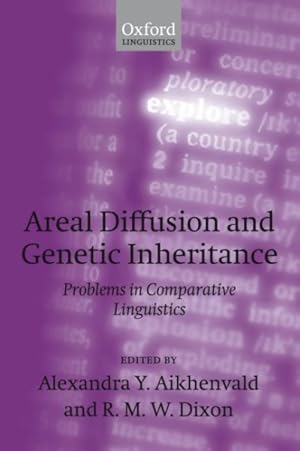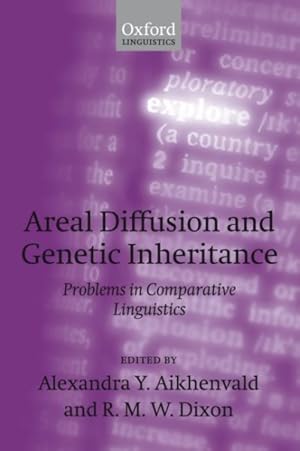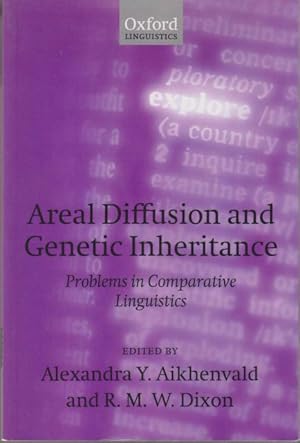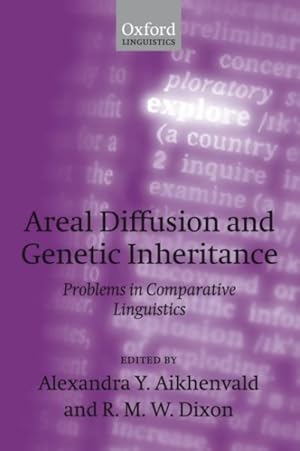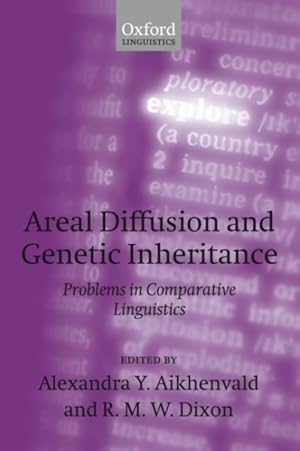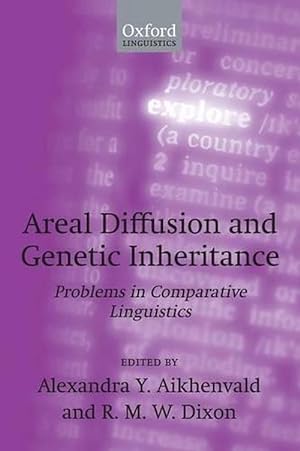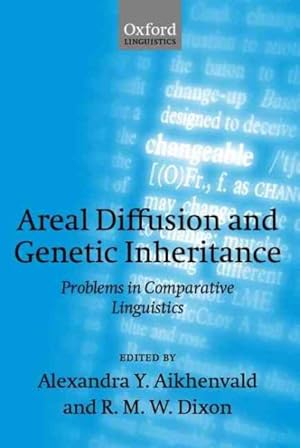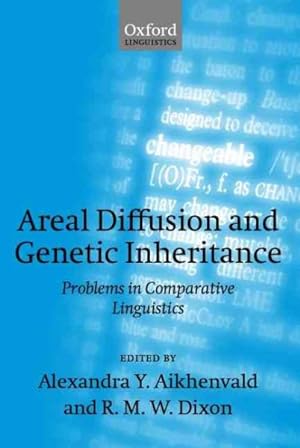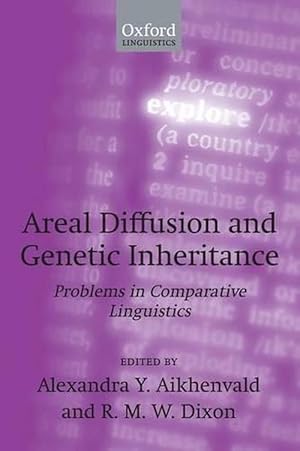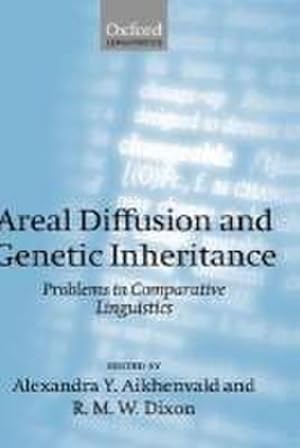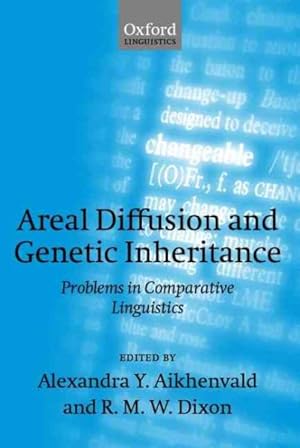Areal Diffusion Genetic Inheritance (46 results)
FeedbackSearch filters
Product Type
- All Product Types
- Books (46)
- Magazines & Periodicals (No further results match this refinement)
- Comics (No further results match this refinement)
- Sheet Music (No further results match this refinement)
- Art, Prints & Posters (No further results match this refinement)
- Photographs (No further results match this refinement)
- Maps (No further results match this refinement)
- Manuscripts & Paper Collectibles (No further results match this refinement)
Condition
Binding
Collectible Attributes
- First Edition (1)
- Signed (No further results match this refinement)
- Dust Jacket (3)
- Seller-Supplied Images (19)
- Not Print on Demand (33)
Language (2)
Free Shipping
Seller Location
Seller Rating
-
Areal Diffusion and Genetic Inheritance. Problems in Comparative Linguistics.
Published by Oxford-New York, Oxford University Press. 2001, 2002
ISBN 10: 0198299818 ISBN 13: 9780198299813
Language: English
Seller: Antiquariaat Schot, Hendrik-Ido-Ambacht, Netherlands
£ 24.67
Convert currency£ 13.01 shipping from Netherlands to United KingdomQuantity: 1 available
Add to basketOriginal publisher's black paper-covered boards, gilt title spine, blue dustjacket, thick 8vo: xvi, 454pp., introduction, 15 contributions with foot- & chapternotes and references - conclusions &c., list contributors, abbreviations, index authors, index languages & language families, index subjects, table of contents. CONTRIBUTORS: Alexandra Y. Aikhenvald - R.M.W. Dixonh - Peter Bellwood - Calvert Watkins - Alan Dench - Malcolm Ross - Geoffrey Haig - Randy J. LaPolla - N.J. Enfield - James A. Matisoff - Hilary Chappell - Gerrit J. Dimmendaal - Bernd Heine - Tania Kuteva - Timothy Jowan Curnow. Very fine copy - as new. Volume Oxford Linguistics.
-
Areal Diffusion and Genetic Inheritance: Problems in Comparative Linguistics (Explorations in Linguistic Typology)
Published by Oxford University Press, UK, 2006
ISBN 10: 0199283087 ISBN 13: 9780199283088
Language: English
Seller: Harry Righton, Evesham, United Kingdom
Soft cover. Condition: Very Good. 453 pages. Size: 8vo - over 7¾ - 9¾" tall. Book.
-
Areal Diffusion and Genetic Inheritance: Problems in Comparative Linguistics
Seller: Chiron Media, Wallingford, United Kingdom
PF. Condition: New.
-
Areal Diffusion And Genetic Inheritance : Problems in Comparative Linguistics
Published by Oxford University Press, 2006
ISBN 10: 0199283087 ISBN 13: 9780199283088
Language: English
Seller: GreatBookPricesUK, Woodford Green, United Kingdom
£ 60.05
Convert currencyFree shipping within United KingdomQuantity: Over 20 available
Add to basketCondition: New.
-
Areal Diffusion and Genetic Inheritance: Problems in Comparative Linguistics (Explorations in Linguistic Typology)
Published by Oxford University Press, 2006
ISBN 10: 0199283087 ISBN 13: 9780199283088
Language: English
Seller: Ria Christie Collections, Uxbridge, United Kingdom
£ 62.52
Convert currencyFree shipping within United KingdomQuantity: Over 20 available
Add to basketCondition: New. In.
-
Areal Diffusion and Genetic Inheritance Problems in Comparative Linguistics
Published by Oxford University Press, 2006
ISBN 10: 0199283087 ISBN 13: 9780199283088
Language: English
Seller: Cider Creek Books, Newark, NJ, U.S.A.
First Edition
£ 39.17
Convert currency£ 27.58 shipping from U.S.A. to United KingdomQuantity: 1 available
Add to basketPaperback. Condition: As New. First Paperback Edition; First Printing. Oxford University Press, 2006. 1st edition, 1st paperback printing. Originally published in 2001. Xvi + [454] pp. Light dust smudge bottom of text block. As New otherwise. ; Explorations In Linguistic Typology; 8vo 8" - 9" tall; 470 pages.
-
Areal Diffusion And Genetic Inheritance : Problems in Comparative Linguistics
Published by Oxford University Press, 2006
ISBN 10: 0199283087 ISBN 13: 9780199283088
Language: English
Seller: GreatBookPricesUK, Woodford Green, United Kingdom
£ 66.66
Convert currencyFree shipping within United KingdomQuantity: Over 20 available
Add to basketCondition: As New. Unread book in perfect condition.
-
Areal Diffusion and Genetic Inheritance (Paperback)
Published by Oxford University Press, Oxford, 2006
ISBN 10: 0199283087 ISBN 13: 9780199283088
Language: English
Seller: CitiRetail, Stevenage, United Kingdom
Paperback. Condition: new. Paperback. Two languages can resemble each other in the categories, constructions, and types of meaning they use; and in the forms they employ to express these. Such resemblances may be the consequence of universal characteristics of language, of chance or coincidence, of the borrowing by one language of another's words, or of the diffusion of grammatical, phonetic, and phonological characteristics that takes place when languages come into contact. Languages sometimes showlikeness because they have borrowed not from each other but from a third language. Languages that come from the same ancestor may have similar grammatical categories and meanings expressed by similarforms: such languages are said to be genetically affiliated. This book considers how and why forms and meanings of different languages at different times may resemble one another. Its editors and authors aim (a) to explain and identify the relationship between areal diffusion and the genetic development of languages, and (b) to discover the means of distinguishing what may cause one language to share the characteristics of another. The introduction outlines the issues thatunderlie these aims, introduces the chapters which follow, and comments on recurrent conclusions by the contributors. The problems are formidable and the pitfalls numerous: for example, several of theauthors draw attention to the inadequacy of the family tree diagram as the main metaphor for language relationship. The authors range over Ancient Anatolia, Modern Anatolia, Australia, Amazonia, Oceania, Southeast and East Asia, and Sub-Saharan Africa. The book includes an archaeologist's view on what material evidence offers to explain cultural and linguistic change, and a general discussion of which kinds of linguistic feature can and cannot be borrowed. The chapters areaccessibly-written and illustrated by twenty maps. The book will interest all students of the causes and consequences of language change and evolution. Considers how and why forms and meanings of different languages at different times may resemble each other. This book investigates the relationship between a real diffusion and the genetic development of languages, and reveals the means of distinguishing what may cause one language to share the characteristics of another. Shipping may be from our UK warehouse or from our Australian or US warehouses, depending on stock availability.
-
£ 33.98
Convert currency£ 10.41 shipping from Sweden to United KingdomQuantity: 1 available
Add to basketXVI, 453 pp. Soft cover. Covers slightly creased, else fine.
-
Areal Diffusion and Genetic Inheritance
Published by Oxford University Press, GB, 2006
ISBN 10: 0199283087 ISBN 13: 9780199283088
Language: English
Seller: Rarewaves.com UK, London, United Kingdom
£ 74.89
Convert currencyFree shipping within United KingdomQuantity: Over 20 available
Add to basketPaperback. Condition: New. Two languages can resemble each other in the categories, constructions, and types of meaning they use; and in the forms they employ to express these. Such resemblances may be the consequence of universal characteristics of language, of chance or coincidence, of the borrowing by one language of another's words, or of the diffusion of grammatical, phonetic, and phonological characteristics that takes place when languages come into contact. Languages sometimes show likeness because they have borrowed not from each other but from a third language. Languages that come from the same ancestor may have similar grammatical categories and meanings expressed by similar forms: such languages are said to be genetically affiliated. This book considers how and why forms and meanings of different languages at different times may resemble one another. Its editors and authors aim (a) to explain and identify the relationship between areal diffusion and the genetic development of languages, and (b) to discover the means of distinguishing what may cause one language to share the characteristics of another. The introduction outlines the issues that underlie these aims, introduces the chapters which follow, and comments on recurrent conclusions by the contributors. The problems are formidable and the pitfalls numerous: for example, several of the authors draw attention to the inadequacy of the family tree diagram as the main metaphor for language relationship. The authors range over Ancient Anatolia, Modern Anatolia, Australia, Amazonia, Oceania, Southeast and East Asia, and Sub-Saharan Africa. The book includes an archaeologist's view on what material evidence offers to explain cultural and linguistic change, and a general discussion of which kinds of linguistic feature can and cannot be borrowed. The chapters are accessibly-written and illustrated by twenty maps. The book will interest all students of the causes and consequences of language change and evolution.
-
Areal Diffusion and Genetic Inheritance: Problems in Comparative Linguistics (Explorations in Linguistic Typology)
Published by Oxford University Press, USA February 2002, 2002
ISBN 10: 0198299818 ISBN 13: 9780198299813
Language: English
Seller: Eighth Day Books, LLC, Wichita, KS, U.S.A.
£ 57.60
Convert currency£ 21.63 shipping from U.S.A. to United KingdomQuantity: 1 available
Add to basketHardcover. Condition: As New. Dust Jacket Condition: As New. As new, in as new jacket.
-
Areal Diffusion And Genetic Inheritance : Problems in Comparative Linguistics
Published by Oxford University Press, 2006
ISBN 10: 0199283087 ISBN 13: 9780199283088
Language: English
Seller: GreatBookPrices, Columbia, MD, U.S.A.
£ 67.72
Convert currency£ 14.91 shipping from U.S.A. to United KingdomQuantity: Over 20 available
Add to basketCondition: New.
-
Areal Diffusion And Genetic Inheritance : Problems in Comparative Linguistics
Published by Oxford University Press, 2006
ISBN 10: 0199283087 ISBN 13: 9780199283088
Language: English
Seller: GreatBookPrices, Columbia, MD, U.S.A.
£ 69.40
Convert currency£ 14.91 shipping from U.S.A. to United KingdomQuantity: Over 20 available
Add to basketCondition: As New. Unread book in perfect condition.
-
Areal Diffusion and Genetic Inheritance: Problems in Comparative Linguistics (Explorations in Linguistic Typology)
Published by Oxford University Press, U.S.A., 2002
ISBN 10: 0198299818 ISBN 13: 9780198299813
Language: English
Seller: Feldman's Books, Menlo Park, CA, U.S.A.
£ 53.76
Convert currency£ 33.56 shipping from U.S.A. to United KingdomQuantity: 1 available
Add to basketHardcover. Condition: Fine. Dust Jacket Condition: Near Fine. 1st Edition. Clean and unmarked.
-
Areal Diffusion and Genetic Inheritance (Paperback)
Published by Oxford University Press, Oxford, 2006
ISBN 10: 0199283087 ISBN 13: 9780199283088
Language: English
Seller: AussieBookSeller, Truganina, VIC, Australia
£ 65.11
Convert currency£ 27.59 shipping from Australia to United KingdomQuantity: 1 available
Add to basketPaperback. Condition: new. Paperback. Two languages can resemble each other in the categories, constructions, and types of meaning they use; and in the forms they employ to express these. Such resemblances may be the consequence of universal characteristics of language, of chance or coincidence, of the borrowing by one language of another's words, or of the diffusion of grammatical, phonetic, and phonological characteristics that takes place when languages come into contact. Languages sometimes showlikeness because they have borrowed not from each other but from a third language. Languages that come from the same ancestor may have similar grammatical categories and meanings expressed by similarforms: such languages are said to be genetically affiliated. This book considers how and why forms and meanings of different languages at different times may resemble one another. Its editors and authors aim (a) to explain and identify the relationship between areal diffusion and the genetic development of languages, and (b) to discover the means of distinguishing what may cause one language to share the characteristics of another. The introduction outlines the issues thatunderlie these aims, introduces the chapters which follow, and comments on recurrent conclusions by the contributors. The problems are formidable and the pitfalls numerous: for example, several of theauthors draw attention to the inadequacy of the family tree diagram as the main metaphor for language relationship. The authors range over Ancient Anatolia, Modern Anatolia, Australia, Amazonia, Oceania, Southeast and East Asia, and Sub-Saharan Africa. The book includes an archaeologist's view on what material evidence offers to explain cultural and linguistic change, and a general discussion of which kinds of linguistic feature can and cannot be borrowed. The chapters areaccessibly-written and illustrated by twenty maps. The book will interest all students of the causes and consequences of language change and evolution. Considers how and why forms and meanings of different languages at different times may resemble each other. This book investigates the relationship between a real diffusion and the genetic development of languages, and reveals the means of distinguishing what may cause one language to share the characteristics of another. Shipping may be from our Sydney, NSW warehouse or from our UK or US warehouse, depending on stock availability.
-
Areal Diffusion and Genetic Inheritance : Problems in Comparative Linguistics
Published by Oxford University Press, 2002
ISBN 10: 0198299818 ISBN 13: 9780198299813
Language: English
Seller: GreatBookPricesUK, Woodford Green, United Kingdom
£ 103.96
Convert currencyFree shipping within United KingdomQuantity: Over 20 available
Add to basketCondition: New.
-
Areal Diffusion and Genetic Inheritance
Published by Oxford University Press, GB, 2006
ISBN 10: 0199283087 ISBN 13: 9780199283088
Language: English
Seller: Rarewaves.com USA, London, LONDO, United Kingdom
£ 85.94
Convert currency£ 25 shipping within United KingdomQuantity: Over 20 available
Add to basketPaperback. Condition: New. Two languages can resemble each other in the categories, constructions, and types of meaning they use; and in the forms they employ to express these. Such resemblances may be the consequence of universal characteristics of language, of chance or coincidence, of the borrowing by one language of another's words, or of the diffusion of grammatical, phonetic, and phonological characteristics that takes place when languages come into contact. Languages sometimes show likeness because they have borrowed not from each other but from a third language. Languages that come from the same ancestor may have similar grammatical categories and meanings expressed by similar forms: such languages are said to be genetically affiliated. This book considers how and why forms and meanings of different languages at different times may resemble one another. Its editors and authors aim (a) to explain and identify the relationship between areal diffusion and the genetic development of languages, and (b) to discover the means of distinguishing what may cause one language to share the characteristics of another. The introduction outlines the issues that underlie these aims, introduces the chapters which follow, and comments on recurrent conclusions by the contributors. The problems are formidable and the pitfalls numerous: for example, several of the authors draw attention to the inadequacy of the family tree diagram as the main metaphor for language relationship. The authors range over Ancient Anatolia, Modern Anatolia, Australia, Amazonia, Oceania, Southeast and East Asia, and Sub-Saharan Africa. The book includes an archaeologist's view on what material evidence offers to explain cultural and linguistic change, and a general discussion of which kinds of linguistic feature can and cannot be borrowed. The chapters are accessibly-written and illustrated by twenty maps. The book will interest all students of the causes and consequences of language change and evolution.
-
Areal Diffusion and Genetic Inheritance : Problems in Comparative Linguistics
Published by Oxford University Press, 2002
ISBN 10: 0198299818 ISBN 13: 9780198299813
Language: English
Seller: GreatBookPrices, Columbia, MD, U.S.A.
£ 102.85
Convert currency£ 14.91 shipping from U.S.A. to United KingdomQuantity: Over 20 available
Add to basketCondition: New.
-
Areal Diffusion and Genetic Inheritance (Hardcover)
Published by Oxford University Press, Oxford, 2001
ISBN 10: 0198299818 ISBN 13: 9780198299813
Language: English
Seller: CitiRetail, Stevenage, United Kingdom
Hardcover. Condition: new. Hardcover. Two languages can resemble each other in the categories, constructions, and types of meaning they use, and in the forms they employ to express these. Such resemblances may be the consequence of universal characteristics of language, of chance or coincidence, of the borrowing by one language of another's words, or of the diffusion of grammatical, phonetic, and phonological characteristics that takes place when languages come into contact. Languages sometimes showlikeness because they have borrowed not from each other but from a third language. Languages that come from the same ancestor may have similar grammatical categories and meanings expressed by similarforms: such languages are said to be genetically affiliated.This book considers how and why forms and meanings of different languages at different times may resemble one another. Its editors and authors aim (a) to explain and identify the relationship between areal diffusion and the genetic development of languages, and (b) to discover the means of distinguishing what may cause one language to share the characteristics of another. The introduction outlines the issues thatunderlie these aims, introduces the chapters which follow, and comments on recurrent conclusions by the contributors. The problems are formidable and the pitfalls numerous: for example, several of theauthors draw attention to the inadequacy of the family tree diagram as the main metaphor for language relationship. The authors range over Ancient Anatolia, Modern Anatolia, Australia, Amazonia, Oceania, Southeast and East Asia, and Sub-Saharan Africa. The book includes an archaeologist's view on what material evidence offers to explain cultural and linguistic change, and a general discussion of which kinds of linguistic feature can and cannot be borrowed. The chaptersare accessibly-written and illustrated by twenty maps. The book will interest all students of the causes and consequences of language change and evolution. Considers how and why forms and meanings of different languages at different times may resemble each other. This book investigates the relationship between areal diffusion and the genetic development of languages. The chapters cover Ancient Anatolia, Modern Anatolia, Australia, Amazonia, Oceania, Southeast and East Asia, and Sub-Saharan Africa. Shipping may be from our UK warehouse or from our Australian or US warehouses, depending on stock availability.
-
Areal Diffusion and Genetic Inheritance: Problems in Comparative Linguistics
Published by Oxford University Press, 2002
ISBN 10: 0198299818 ISBN 13: 9780198299813
Language: English
Seller: THE SAINT BOOKSTORE, Southport, United Kingdom
Hardback. Condition: New. New copy - Usually dispatched within 4 working days. 849.
-
Areal Diffusion and Genetic Inheritance (Paperback)
Published by Oxford University Press, Oxford, 2006
ISBN 10: 0199283087 ISBN 13: 9780199283088
Language: English
Seller: Grand Eagle Retail, Mason, OH, U.S.A.
£ 97.18
Convert currency£ 37.28 shipping from U.S.A. to United KingdomQuantity: 1 available
Add to basketPaperback. Condition: new. Paperback. Two languages can resemble each other in the categories, constructions, and types of meaning they use; and in the forms they employ to express these. Such resemblances may be the consequence of universal characteristics of language, of chance or coincidence, of the borrowing by one language of another's words, or of the diffusion of grammatical, phonetic, and phonological characteristics that takes place when languages come into contact. Languages sometimes showlikeness because they have borrowed not from each other but from a third language. Languages that come from the same ancestor may have similar grammatical categories and meanings expressed by similarforms: such languages are said to be genetically affiliated. This book considers how and why forms and meanings of different languages at different times may resemble one another. Its editors and authors aim (a) to explain and identify the relationship between areal diffusion and the genetic development of languages, and (b) to discover the means of distinguishing what may cause one language to share the characteristics of another. The introduction outlines the issues thatunderlie these aims, introduces the chapters which follow, and comments on recurrent conclusions by the contributors. The problems are formidable and the pitfalls numerous: for example, several of theauthors draw attention to the inadequacy of the family tree diagram as the main metaphor for language relationship. The authors range over Ancient Anatolia, Modern Anatolia, Australia, Amazonia, Oceania, Southeast and East Asia, and Sub-Saharan Africa. The book includes an archaeologist's view on what material evidence offers to explain cultural and linguistic change, and a general discussion of which kinds of linguistic feature can and cannot be borrowed. The chapters areaccessibly-written and illustrated by twenty maps. The book will interest all students of the causes and consequences of language change and evolution. Considers how and why forms and meanings of different languages at different times may resemble each other. This book investigates the relationship between a real diffusion and the genetic development of languages, and reveals the means of distinguishing what may cause one language to share the characteristics of another. Shipping may be from multiple locations in the US or from the UK, depending on stock availability.
-
Areal Diffusion and Genetic Inheritance: Problems in Comparative Linguistics (Explorations in Linguistic Typology)
Published by Oxford University Press, 2006
ISBN 10: 0199283087 ISBN 13: 9780199283088
Language: English
Seller: Lucky's Textbooks, Dallas, TX, U.S.A.
£ 80.39
Convert currency£ 55.93 shipping from U.S.A. to United KingdomQuantity: Over 20 available
Add to basketCondition: New.
-
Areal Diffusion and Genetic Inheritance: Problems in Comparative Linguistics (Explorations in Linguistic Typology)
Published by Oxford University Press, 2006
ISBN 10: 0199283087 ISBN 13: 9780199283088
Language: English
Seller: HPB-Red, Dallas, TX, U.S.A.
£ 54.94
Convert currency£ 85.75 shipping from U.S.A. to United KingdomQuantity: 1 available
Add to basketPaperback. Condition: Good. Connecting readers with great books since 1972! Used textbooks may not include companion materials such as access codes, etc. May have some wear or writing/highlighting. We ship orders daily and Customer Service is our top priority!
-
Areal Diffusion and Genetic Inheritance: Problems in Comparative Linguistics (Explorations in Linguistic Typology)
Published by Oxford University Press, 2002
ISBN 10: 0198299818 ISBN 13: 9780198299813
Language: English
Seller: Lucky's Textbooks, Dallas, TX, U.S.A.
£ 101.82
Convert currency£ 55.93 shipping from U.S.A. to United KingdomQuantity: Over 20 available
Add to basketCondition: New.
-
Areal Diffusion and Genetic Inheritance
Published by Oxford University Press, 2006
ISBN 10: 0199283087 ISBN 13: 9780199283088
Language: English
Seller: OM Books, Sevilla, SE, Spain
£ 150.13
Convert currency£ 15.18 shipping from Spain to United KingdomQuantity: 1 available
Add to basketCondition: Usado - bueno.
-
£ 164.58
Convert currency£ 6.71 shipping from U.S.A. to United KingdomQuantity: 4 available
Add to basketCondition: New. pp. 472.
-
Areal Diffusion and Genetic Inheritance : Problems in Comparative Linguistics
Published by Oxford University Press (UK) Feb 2002, 2002
ISBN 10: 0198299818 ISBN 13: 9780198299813
Language: English
Seller: AHA-BUCH GmbH, Einbeck, Germany
£ 159.17
Convert currency£ 12.14 shipping from Germany to United KingdomQuantity: 2 available
Add to basketBuch. Condition: Neu. Neuware - This book considers how and why forms and meanings of different languages at different times may resemble one another. Its editors and authors aim to explain and identify the relationship between areal diffusion and the genetic development of languages, and to discover the means of distinguishing what may cause one language to share the characteristics of another.
-
Areal Diffusion and Genetic Inheritance : Problems in Comparative Linguistics
Published by Oxford University Press, 2002
ISBN 10: 0198299818 ISBN 13: 9780198299813
Language: English
Seller: GreatBookPricesUK, Woodford Green, United Kingdom
£ 205.99
Convert currencyFree shipping within United KingdomQuantity: Over 20 available
Add to basketCondition: As New. Unread book in perfect condition.
-
Areal Diffusion and Genetic Inheritance: Problems in Comparative Linguistics (Explorations in Linguistic Typology)
Published by Oxford University Press, 2002
ISBN 10: 0198299818 ISBN 13: 9780198299813
Language: English
Seller: Mispah books, Redhill, SURRE, United Kingdom
Hardcover. Condition: Like New. Like New. book.
-
Areal Diffusion and Genetic Inheritance: Problems in Comparative Linguistics (Explorations in Linguistic Typology)
Published by Oxford University Press, 2002
ISBN 10: 0198299818 ISBN 13: 9780198299813
Language: English
Seller: Ria Christie Collections, Uxbridge, United Kingdom
£ 208.78
Convert currencyFree shipping within United KingdomQuantity: Over 20 available
Add to basketCondition: New. In.




